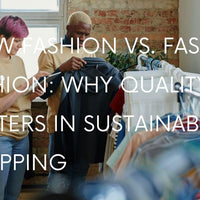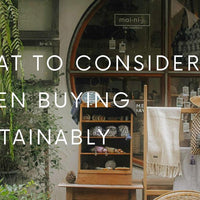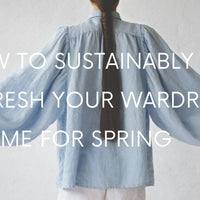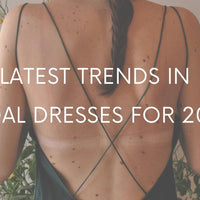In a world where we’re bombarded with hundreds of fast-fashion ads on a daily basis, the rise of sustainable fashion isn't just a trend…it’s a breath of fresh air. The sustainable fashion brands of today have been known for doing away with passing trends and sales patterns, opting instead to price their green garments with materials, production, and transportation costs (and even emissions) in mind.
And with this ‘back to basics’ approach, we’re seeing a real shift in the fashion industry’s collective eco-consciousness and social consciousness. Clothing made with eco-friendly or sustainably sourced fabrics has also proven to be more comfortable, climate-adaptive, and durable – ensuring that consumers are getting lasting value with every purchase.
But there’s one other element of sustainable fashion production that’s generated surprising benefits, and that’s developing unisex clothing, and even expanding their basics ranges to include gender-affirming underwear. Shifting away from just producing garments in men’s and women’s cuts and producing for new markets like period underwear, tucking gaffs, binders, and other inclusive basics, have allowed sustainable fashion brands to boost the versatility and inclusivity of their labels alongside considering their triple bottom line.
Today we explore the importance of sustainability in the inclusive fashion movement, so read on to find out more.
What Is Sustainable Fashion?
To break it down simply and without any confusing jargon, sustainable fashion is a conscious effort to prioritise the planet and the people on it at every stage of clothing production. It refers to a wide range of processes, designs, and materials — from the input of environmentally safe materials like organic cotton and recycled materials, to fair labour practices and minimising waste and carbon emissions. The ultimate goal of sustainable fashion is to make the clothing industry more ethical and sustainable.
From a consumer perspective, sustainable fashion can also refer to any clothing brands that don’t design for trends but rather for durability and functionality. This can include labels that produce a range of basics like inclusive bras and undies and unisex garments, and labels that work with versatile organic fibres like wool, bamboo cotton, tencel, or cactus leather.
How We Can Improve Inclusivity In Sustainable Fashion
Despite this noble collective goal for reducing the environmental impact of the global fashion industry, there is a major flaw in the sustainable fashion industry. Many sustainable brands fail to offer sizing that is inclusive of larger people, nor do they cater to various gender identities. For example, when was the last time you saw a sustainable brand offer clothing above size 16? More often than not, people who fall under these categories have to rely on fast-fashion brands or compromise their values in order to find clothing that fits and aligns with their unique identity.
This oversight not only perpetuates exclusionary practices but also undermines the core values of sustainability. After all, how can we claim to be promoting ethical and responsible fashion when a significant portion of the population is alienated from the conversation?
So, the next step to greenifying the fashion industry is arguably quite simple. Alongside better accommodating non-binary and gender-diverse consumers, sustainable fashion brands can also encourage their shoppers to ditch fast fashion by ensuring their labels are inclusive of plus size bodies as well.
Why Sustainability is Integral to the Inclusive Fashion Movement
Addressing Exclusionary Practices
It’s no guarded secret that traditional fashion has long perpetuated seriously unrealistic beauty standards and strict gender norms, leaving many people who don’t fit into a “cookie cutter image” feeling excluded and marginalised. Think about it: how many times have “real-life” models that represent the majority of us been represented on the catwalk? Not often enough, that’s for sure.
The good news is that by linking sustainability with inclusive fashion, brands now have the ability to challenge (outdated) exclusionary practices and create a more welcoming and representative fashion industry. Imagine flipping through a fashion magazine and watching models of all shapes, sizes, and backgrounds strut their stuff in the most contemporary sustainable trends. It's not just about promoting or selling this season’s latest threads: it's about celebrating diversity and empowering individuals to embrace their unique selves.
Take for example, Rihanna’s lingerie line, Savage X Fenty, which exemplifies this concept beautifully. By incorporating women of all body shapes and colours, Rihanna has changed the way fashion defines beauty. Similarly, sustainable brands like Reformation and Girlfriend Collective are leading the pack by offering size-inclusive and gender-neutral options, proving that sustainability and inclusivity can indeed go hand in hand.
Reducing Reliance on Fast Fashion
We all know that fashion has long been criticised for its harmful environmental and social impact, but we have to begrudgingly admit that one area where it has really excelled is in offering a wide range of sizes and styles that cater to every body type. There’s really no denying it, regardless of how you feel about fast fashion. However, as sustainable fashion gains momentum, brands can capitalise on this by expanding their size and gender offerings to tap into a larger share of the market while offering consumers more ethical and inclusive alternatives.
Here’s where Lithuanian clothing company Odalux sets a great example. Famous for its transparent supply chain and dedication to sustainability by using linen textiles, Odalux has also pushed boundaries by offering an affordable series of sizes, even up to 2XL in some styles. Their range of linen dresses, collared shirts, and cosy basics makes them a popular brand here at Velvety. Similarly, brands like Nich have also gained a loyal following thanks to their inclusive offerings, proving that sustainability and inclusivity can indeed go hand in hand.
Fostering Innovation and Creativity
Creating sustainable fashion pieces for the “average” body type is as easy as following textiles templates for standard sizes. But by combining sustainability with inclusivity, there is a demand for brands to foster innovation and creativity in their design and manufacturing processes.
Sustainability makes brands think about their customers in a broader context. It means that brands need to find creative ways to include more size-inclusive, gender-neutral, and culturally diverse choices that customers are demanding in this day and age. It’s about thinking outside of the box and challenging the status quo.
Rather than abiding by archaic beauty ideals or limited perceptions of gender, sustainable fashion opens up infinite opportunities for people to feel included, listened to, and respected. It’s not just about manufacturing clothes; it’s about creating a lifestyle that honours differences and allows people to feel comfortable expressing themselves creatively through fashion.
To Sum It Up
In the end, sustainability and inclusivity are the common threads that create a brighter future — no pun intended. Whether it’s pushing back against traditional definitions of beauty or embracing different body shapes and gender identities, the inclusive fashion movement is a celebration of individuality and empowerment.
And so, here’s to a future in which sustainability and inclusivity is the name of the game, in which style isn’t about what you wear but rather how you wear it, and what you stand for. Let’s keep kicking down walls, breaking down barriers and laying new ones for a fashion industry that makes diversity in all shapes and colours a priority. After all, it’s not just about looking great — it’s also about feeling great.








0 comments